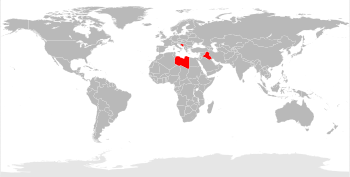
Back منطقة حظر جوي Arabic Zona d'exclusió aèria Catalan Bezletová zóna Czech Gwaharddiad hedfan Welsh Flyveforbudszone Danish Flugverbotszone German Ζώνη απαγόρευσης πτήσεων Greek Senaviada zono Esperanto Zona de exclusión aérea Spanish Lennukeeluala Estonian

A no-fly zone, also known as a no-flight zone (NFZ), or air exclusion zone (AEZ),[1] is a territory or area established by a military power over which certain aircraft are not permitted to fly. Such zones are usually set up in an enemy power's territory during a conflict for humanitarian or military reasons without consent of the enemy state, similar in concept to an aerial demilitarized zone, and usually intend to prohibit the enemy's military aircraft from operating in the region. Military action is employed by the enforcing state and, depending on the terms of the NFZ, may include preemptive attacks to prevent potential violations, reactive force targeted at violating aircraft, or surveillance with no use of force. Air exclusion zones and anti-aircraft defences are sometimes set up in a civilian context, for example to protect sensitive locations, or events such as the 2012 London Olympic Games, against terrorist air attack. A no-fly zone is generally not considered a form of aerial blockade due to its more limited scope compared to an aerial blockade.[2]
No-fly zones are a modern phenomenon established in the 1990s. They can be distinguished from traditional air power missions by their coercive appropriation of another nation's airspace only, to achieve aims on the ground within the target nation. While the Royal Air Force (RAF) conducted prototypical air control operations over various contentious colonies between the two World Wars, no-fly zones did not assume their modern form until the end of the Gulf War in 1991.[3]
During the Cold War, the risk of local conflict escalating into nuclear showdown made military intervention as a tool of United States statecraft unappealing. Furthermore, air power was a relatively blunt instrument until the operational maturation of stealth and precision-strike technologies. Before the Gulf War of 1991, it had not been possible to perform nuanced attacks against transitory, difficult-to-reach targets, and air power thus lacked the ability to produce decisive political effects short of total war. However, the demise of the Soviet Union and technological advances in aerospace capabilities made no-fly zones viable in both political and military contexts.[3]
Enforcement of a no-fly zone is subject to the rules of armed conflict under international humanitarian law.[2]
- ^ Long, Robert A. (June 2012). The Coercive Efficacy of Air Exclusion Zones Myth or Reality (PDF) (Thesis). United States Air Force School of Advanced Air and Space Studies. Archived (PDF) from the original on February 16, 2022. Retrieved 31 January 2019.
Fortunately, a more complete concept, the Air Exclusion Zone (AEZ), will satisfy those seeking clarity.
- ^ a b Schmitt, Michael N. (2022-03-18). "A No-Fly Zone over Ukraine and International Law". Lieber Institute of West Point.
- ^ a b "Air Exclusion Zones: An Instrument for Engagement in a New Century," Brig General David A. Deptula, in "Airpower and Joint Forces: The Proceeding of a Conference Held In Canberra by the RAAF, 8–9 May 2000," "Conference Proceedings". airforce.gov.au. Archived from the original on 20 March 2015. Retrieved 16 May 2015.
© MMXXIII Rich X Search. We shall prevail. All rights reserved. Rich X Search